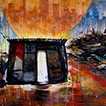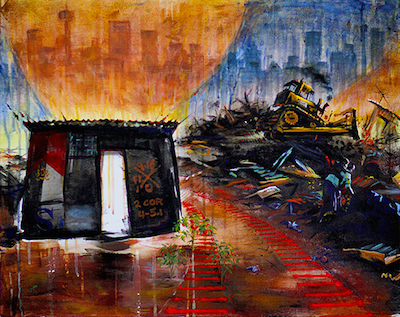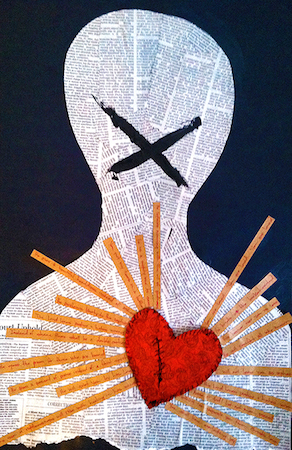The Arts and Trauma Healing

SYMPTOMS OF TRAUMA
When people are overwhelmed with intense fear, helplessness and horror in the face or threat of death, they can be traumatized.1 Trauma manifests itself as symptoms such as:
- intrusive thoughts in which people re-experience the event;
- avoidance of things associated with the event;
- being on alert all the time.
 For traumatized people to find healing, they need to express their pain. They need a safe place to express it, where they will not be attacked physically or verbally. They need someone who will listen.
For traumatized people to find healing, they need to express their pain. They need a safe place to express it, where they will not be attacked physically or verbally. They need someone who will listen.
Both internal and external forces work against this expression of pain. Since pain hurts, denial can sometimes seem like a better option. The church and culture are often complicit in this denial, teaching Christians that they should express praise and joy in all circumstances. In many places around the world, human feelings of anger, doubt, and abandonment are not accepted as appropriate for Christians. I observed this in the words of a South Sudanese priest who said to me, “I saw my son get shot. I praised God. I need to be an example to the believers.”
THE BIBLE HONORS VOICES OF PAIN
In fact, however, laments are sprinkled throughout the Bible. Christ lamented on the cross: “Why have you abandoned me?” A psalmist laments, “How long, oh Lord?” There are more lament psalms than any other category in the book of Psalms. One entire book of the Bible, the book of Lamentations, is a lament. Kathleen O’Connor writes, “Lamentations expresses human experiences of abandonment with full force. And because God never speaks, the book honors voices of pain. Lamentations is a house for sorrow because there is no speech for God.” 2 She adds, “Any words from God would...undercut anger and despair, foreshorten protest, and give the audience only a passing glimpse of the real terror of their condition. Divine speaking would trump all speech.”3 Laments like the book of Lamentations show the way for those who are traumatized to express their pain to God honestly and forcefully.
THE USE OF ART FORMS IN HEALING PAIN
People can use their art forms as they seek healing from their pain. My experience in Africa has shown me that almost every culture of that continent has a lament tradition: certain melodies, certain kinds of poetry, certain dances and postures. Often these lament traditions have been condemned as heathen and off-limits for Christians. I have observed that when African Christians understand the structure of lament Psalms in the Bible, it only takes a bit of encouragement for them to use their own lament traditions to express their pain to God. In thirty minutes of centering prayer and listening to the inner cry of their hearts, laments are expressed.
 Sometimes these laments are expressed in prose, but more often words alone do not suffice; they must be expressed in song, dance, poetry, visual arts, or drama. Sometimes these laments are expressed by individuals or as a group. The piercing cry of a Niaboua pastor grieving the death of his sister still rings in my ears.
Sometimes these laments are expressed in prose, but more often words alone do not suffice; they must be expressed in song, dance, poetry, visual arts, or drama. Sometimes these laments are expressed by individuals or as a group. The piercing cry of a Niaboua pastor grieving the death of his sister still rings in my ears.
Laments do not know age, color, or gender. Children can lament as well as adults, Westerners as well as Southerners. When pain is expressed, healing often follows. And the songs shared bring healing to others.
People can also learn new art forms. I lived in Africa for twenty years and never saw adults draw pictures; certainly not church leaders. But when Africans were given some markers and paper and a bit of explanation at the workshop—“get quiet inside and let the pain come out through your fingers”—it seemed that drawing is a native language of Africa. As people drew their pain, they were able to express it in ways that words cannot. One pastor from Côte d’Ivoire looked at his drawing and said, “That’s it! That’s how I feel! I didn’t realize it was so bad.” And as a small group we discussed the drawing, unpacking layer after layer of pain and loss.
BRINGING OUR PAIN TO THE CROSS
Getting the pain out is part of the healing process.4 As Christians, we can bring that pain—those drawings, sung laments, poetry, enacted pain—to the cross of Christ, because he died not only to forgive our sins but also to carry our sorrows. At the cross of Christ those pains that we have been able to express are absorbed by his death, bringing healing to our wounded hearts.5
photo credits:
“A Visual Lament” by Walter Bowen, concerning the injustice and suffering experienced by forced displacement, derived from the artist’s personal experience and those of his friends living in the townships of South Africa. (http://www.psabowen.com)
Jessica Martin— “Mended Grief.”









comments